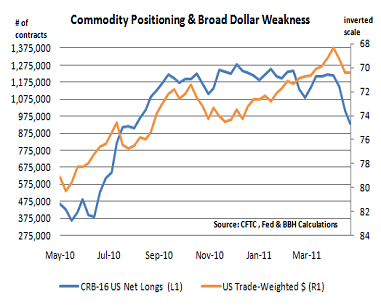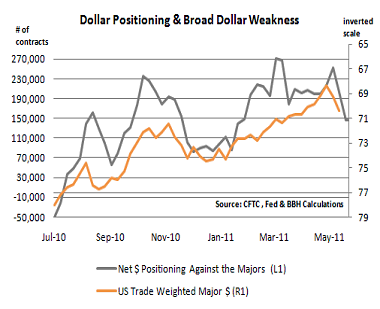FX: Is a Correlation Consolidation Ahead?
BBH FX Special
By Lena Komileva, Global Head of G10 Currency Strategy and Mark McCormick, Currency Strategist at Brown Brothers Harriman
In this recent bout of risk aversion the currencies most impacted by the sell-off in equities and commodities, besides the euro, have generally been the growth-sensitive currencies of the dollar bloc and the Scandis. Over the past month, for instance, the Scandis have fallen versus the dollar by more than 4% followed by losses of more than 2% for the dollar bloc currencies (although the NZD has only fallen by 1.7% against the dollar). In our view, one of the key drivers of this recent unwind is the recoupling of short-term correlations between asset classes as the run-up to QE2 induced demand for higher yielding assets and in turn led to the outperformance of stocks, commodities and higher-yielding currencies, while the market funded these trades through short dollar positions. But with the cyclical rise in correlations nearing recent peaks could we be in store for a return of a broader normalization of cross asset trading patterns, which would signal a decoupling of cross asset correlations and in turn a focus back to economic fundamentals and a softer dollar?
The relative changes in the correlations in the G10 have painted a pretty broad picture since the market began to price in QE2 in the summer of 2010. From August 2010 to December 2010 the correlation of the percentage change between CAD, AUD, and NZD and the S&P and oil gradually firmed, with CAD and AUD holding the strongest link to the relative changes in stocks and oil. Over this time period, for instance, the correlation based on relative changes between CAD and AUD and the S&P and oil was over -0.73, indicating a very strong relationship. This is likely driven in part by the fact that the goal of QE2 was to spur a type of wealth effect, where low real yields would crowd out investment into Treasuries and in turn prompt demand for "risky" assets, including equities and commodities. This is indeed the likely outcome with perhaps one unintended consequence: a one-sided traded where investors shorted the dollar and bought nearly everything else, which substantially increased the correlation between asset classes as momentum traders piled in.
As you can from the charts below the anticipation of QE2 and the immediate follow through subsequent the Jackson Hole speech saw a marked shift in speculative investment positions, with a protracted selloff in the dollar and a large accumulation of commodity contracts. Beginning in mid July, for instance, net speculative short dollar contracts against the majors increased by nearly 200k, while the net long contracts of the 16 most traded commodity futures increased by nearly 831k contracts over the same time period. At the same time this major shift in positioning also coincides with the rise in correlations across asset classes, with the dollar declining on a broad basis against most of the US’s major trading partners and equity and commodities taking their next leg higher. But as investors started to embrace the global reflation trade, the correlations of currencies to major assets classes started to break down in early 2011 as a more nuanced picture began to emerge driven in part by economic fundamentals.
For one thing natural disasters in Australia, New Zealand and Japan may have disrupted the relationship between currencies and other asset classes in the early part of Q1. Yet more importantly it is more likely that idiosyncratic economic factors became a more pronounced driver of currencies at this time as it became clear each country was headed in a different direction and therefore each country required its own policy mix to manage its phase of economic growth. Overall, in our view the breakdown in correlations in late Q1 and early Q2 was predicated on shift towards economic fundamentals and the policy outlook for central banks as a much more important driver of currencies than the simple "risk-on/risk-off" framework. This, in fact, led to a sharp decline of the correlations with relative changes in the correlation of CAD, AUD, NZD, in particular, against the S&P and oil falling to insignificant (near zero) levels from late January 2011 to early April 2011.
After a few month hiatus, it was not until last month that the correlations started to creep up again as investors become concerned about the strength of the reflation trade and indeed began to wonder if the real demand in the global economy actually supported current market prices. As such, the recent consolidation of prices is likely a recalibration of the short-term economic views. And yet, in our view, the recent selloff is more of a consolidation than an actual correction in asset prices that has likely been triggered by a mid-cycle slowdown in economic data and a flare up in the euro zone debt crisis. Indeed, it has become apparent after the fact that positioning has become somewhat over-extended in some markets and when considered across markets it is probably overextended due to the same underlying themes, which are driven by loose financial conditions.
While the tightening of global financial conditions is likely in part a trigger for the recent unwind of positioning, the de-leveraging of this extended positioning in equities, commodities and currencies, therefore, is the likely the cause of the re-coupling of the correlation across asset classes. In any event, we suspect that this bout of re-coupling may have some further room to go but overall we expect that the mean reversion tendency of correlations is likely to take hold at some point as the correlations of currencies to the equities and commodities are nearing cyclical highs, while the Fed’s QE2 is coming to an end. That would mean a return of more idiosyncratic trading conditions. This, however, is conditional upon two major factors. First, that financing conditions after the end of the Fed’s QE2 remains supportive of risk sentiment. And finally that a likely Greek debt restructuring is managed in a fairly controlled way with minimum contagion across the financial system.
Lena Komileva & Mark McCormick
FX Strategy


Comments are closed.